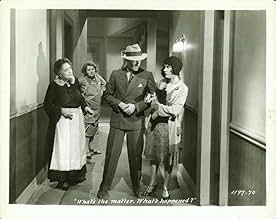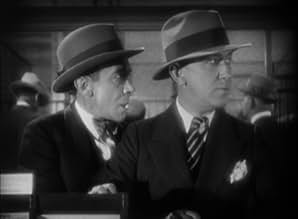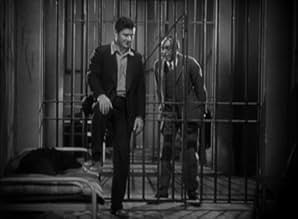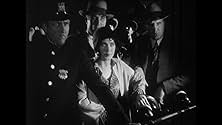Thunderbolt, big boss de Harlem, apprend que Ritzy veut le quitter pour un employé de banque. Pour s'en débarrasser elle le livre à la police. Même depuis le couloir de la mort de Sing-Sing,... Tout lireThunderbolt, big boss de Harlem, apprend que Ritzy veut le quitter pour un employé de banque. Pour s'en débarrasser elle le livre à la police. Même depuis le couloir de la mort de Sing-Sing, Thunderbolt cherchera à éliminer son rival.Thunderbolt, big boss de Harlem, apprend que Ritzy veut le quitter pour un employé de banque. Pour s'en débarrasser elle le livre à la police. Même depuis le couloir de la mort de Sing-Sing, Thunderbolt cherchera à éliminer son rival.
- Réalisation
- Scénario
- Casting principal
- Nommé pour 1 Oscar
- 2 victoires et 1 nomination au total
Ernie Adams
- Thug in Bank at Robbery
- (non crédité)
Elmer Ballard
- Prisoner #8
- (non crédité)
Louise Beavers
- Black Cat Cafe Patron
- (non crédité)
Ed Brady
- Chuck - 1st Prisoner #5
- (non crédité)
Avis à la une
If you can get past the really rather stilted production here - almost stage bound in it's presentation, this is quite an entertaining film that sees the authorities on the trail of the most wanted "Thunderbolt" (George Bancroft). He is elusive, though - and their only route to him might be through his ex-girfriend "Ritzie" (Fay Wray) - but she isn't playing ball for reasons of her own. It's only when "Thunderbolt" makes good on an earlier threat he made to her about seeing anyone else, that the police see some light. The performances are fine, not great but the writing is really quite good - plenty of quirky vernacular and it moves along well despite the frequent silent movie style direction and scene framing from Josef von Sternberg. There is also quite an enjoyable contribution from a blues ensemble and though certainly dated, this is still worth a watch almost 100 years later.
This film begins with the news that an elusive gangster nicknamed "Thunderbolt" (George Bancroft) is wanted for bank robbery and is considered armed and dangerous. That being said, as the film continues it is also revealed that Thunderbolt has a girlfriend named "Ritzi" (Fay Wray) that he is obsessed with. The problem is that Thunderbolt has become, not only extremely possessive of Ritzi, but somewhat abusive as well. So, because of that, Ritzi has since fallen in love with a gentle man named "Bob Moran" (Richard Arlen) who simply adores her. Needless to say, Thunderbolt becomes quite livid when he learns that Ritzi wants to break up with him because she has found another man. So much so that not even the death penalty can prevent him from getting his revenge. Now, rather than reveal any more, I will just say that I was pleasantly surprised with the menacing performance George Bancroft put in for this particular role. Absolutely outstanding. That being said, however, it's also quite obvious that all of the actors labored to some degree from the transition from silent films. An unfortunate byproduct of its time. Be that as it may, I still found this film to be entertaining for the most part and I have rated it accordingly. Slightly above average.
Nobody would argue that 1929 was a year of classic movies. Amongst the flotsam and jetsam however there's APPLAUSE and a few other good ones..... and this as well - almost. What a difference a top director and screenwriter can make!
This isn't a gangster film, it's an intelligently written character study and in-depth look into the mind of a mobster. You find writer Jules Furthman's name on virtually every other classic Hollywood picture of the 20s, 30s and 40s. His style was quality and his skill was creating believable engaging stories with real genuine characters. His story was further adapted by H Mankiewicz - who wrote the scripts for the probably the other half of the classics from this period. Needless to say - this is well written with fascinating and deeply faceted characters.
Josef von Sternberg directed this which by the look of it was his fiftieth talkie. Surely it's impossible that this was his first sound film? Being made in 1929, it's still a little experimental, not quite everything works so this is not one of his best pictures. Nevertheless he creates a brooding almost surreal atmosphere with real tension. That style intensifies significantly in the latter part of the film on death row which has an almost dream like feel about it.
The story is tense, the characters are believable, the production is innovative but this is not a perfect film. To enable clear sound recording, some but not all of the actors speak very slowly which sounds especially weird when the actor they're talking with is speaking normally. Actors had their own individual vocal coaches then with different techniques thus the inconsistency and maybe not being a native English speaker, von Sternberg probably didn't notice the subtle differences.
As great a director as he was, von Sternberg was given the impossible task of trying to make Fay Wray seem like a proper actress. Not even he could do that and predictably she's absolutely dreadful. As always she just projects that limp, whining and insipid expression to convey whatever emotion she's trying to express.
Whether she's pretending to be a hard as nails gangster's moll or a reformed, sweet and vulnerable fragile young thing she's that same bland, shallow character. Not only can't she act but in this she doesn't appear to be able to speak English - what on earth is that accent! She's meant to be a girl from the streets so why is she doing history's worst impression of Queen Mary? That two men could be besotted with this dull sour-faced non-entity completely stretches all credibility.
This isn't a gangster film, it's an intelligently written character study and in-depth look into the mind of a mobster. You find writer Jules Furthman's name on virtually every other classic Hollywood picture of the 20s, 30s and 40s. His style was quality and his skill was creating believable engaging stories with real genuine characters. His story was further adapted by H Mankiewicz - who wrote the scripts for the probably the other half of the classics from this period. Needless to say - this is well written with fascinating and deeply faceted characters.
Josef von Sternberg directed this which by the look of it was his fiftieth talkie. Surely it's impossible that this was his first sound film? Being made in 1929, it's still a little experimental, not quite everything works so this is not one of his best pictures. Nevertheless he creates a brooding almost surreal atmosphere with real tension. That style intensifies significantly in the latter part of the film on death row which has an almost dream like feel about it.
The story is tense, the characters are believable, the production is innovative but this is not a perfect film. To enable clear sound recording, some but not all of the actors speak very slowly which sounds especially weird when the actor they're talking with is speaking normally. Actors had their own individual vocal coaches then with different techniques thus the inconsistency and maybe not being a native English speaker, von Sternberg probably didn't notice the subtle differences.
As great a director as he was, von Sternberg was given the impossible task of trying to make Fay Wray seem like a proper actress. Not even he could do that and predictably she's absolutely dreadful. As always she just projects that limp, whining and insipid expression to convey whatever emotion she's trying to express.
Whether she's pretending to be a hard as nails gangster's moll or a reformed, sweet and vulnerable fragile young thing she's that same bland, shallow character. Not only can't she act but in this she doesn't appear to be able to speak English - what on earth is that accent! She's meant to be a girl from the streets so why is she doing history's worst impression of Queen Mary? That two men could be besotted with this dull sour-faced non-entity completely stretches all credibility.
During the early days of talkies, dialogue writers were in great demand, and many who made the move to California were involved in the Broadway theater industry. The first regular theater critic for The New Yorker, Herman Mankiewicz, was soon in high demand in Hollywood after synchronized sound was introduced to cinema. A prime example of Mankiewicz's style was his screenplay in the early talkie, June 1929 "Thunderbolt." In 1927 Paramount Pictures hired Mankiewicz to write scenarios for its silent films. The studio asked him to work his connections for New York City writers to compose film scripts when talkies arrived. "Most of the newer writers on Paramount's staff who contributed the most successful stories of the past year (1929) were selected by 'Mank,'" wrote film critic Pauline Kael. Herman was the subject in the Netflix 2020 biopic, "Mank."
Mankiewicz's famous telegram to Ben Hecht describes how desperate movie studios were to hire good writers. "Millions are to be grabbed out here and your only competition is idiots. Don't let this get around."
Mankiewicz was the highest-paid writer in Tinseltown. Kael described, "His heroes weren't soft-eyed and bucolic; he brought good-humored toughness to the movies, and energy and astringency. And the public responded, because it was eager for modern American subjects." In "Thunderbolt," adapted from a Charles and Jules Furthman story, Mankiewicz's script focuses on Jim Lang (George Bancroft), nicknamed Thunderbolt, wanted by the police. His girlfriend, 'Ritzy' (Fay Wray), is seeing banker Bob Moran (Richard Arlen) behind Jim's back. Lang is captured and is headed for the chair. In jail, he discovers who Ritzy's boyfriend is and frames Bob in a cop's murder. When arrested and sentenced, Bob finds himself in the jail cell next to Thunderbolt.
"Thunderbolt" was the type of movie designed for director Josef von Sternberg for his first talkie. The silent movie director of 1927's "Underworld," which introduced the gangster genre, was excited to be making talkies. He said he was "no longer at the mercy of movie house organists."
Sternberg especially loved to mix music with his actors' dialogue. In a classic nightclub scene, singer actress Theresa Harris, in her film debut, belts out a song while Thunderbolt and Ritzy are in an argument. Between Harris' numbers, the jazz band plays in the background while tension builds between Lang and nearby loud customers. The tense sequence reveals the inner turmoil of Thunderbolt. Film critic Andrew Sarris notes, "'Thunderbolt' is, in some respects, as much a musical as a melodrama." Sternberg was praised overseas for his film, receiving a telegram from German director Ludwig Berger, stating "I saw your film 'Thunderbolt' and congratulate you with all my heart. It is the first fully realized and artistically accomplished sound film. Bravo!" "Thunderbolt" was the second talkie for actor George Bancroft, his first was the now lost 1929 'The Wolf of Wall Street.' The actor earned a Best Actor Academy Award nomination for his role as Thunderbolt.
The future was bright for Mankiewicz, working alongside his younger brother, Joseph, who wrote the titles in "Thunderbolt." Herman is known by today's movie fans as the first screenwriter for 1939's "The Wizard of Oz," and for his collaboration with Orson Welles in 1941's "Citizen Kane."
Mankiewicz's famous telegram to Ben Hecht describes how desperate movie studios were to hire good writers. "Millions are to be grabbed out here and your only competition is idiots. Don't let this get around."
Mankiewicz was the highest-paid writer in Tinseltown. Kael described, "His heroes weren't soft-eyed and bucolic; he brought good-humored toughness to the movies, and energy and astringency. And the public responded, because it was eager for modern American subjects." In "Thunderbolt," adapted from a Charles and Jules Furthman story, Mankiewicz's script focuses on Jim Lang (George Bancroft), nicknamed Thunderbolt, wanted by the police. His girlfriend, 'Ritzy' (Fay Wray), is seeing banker Bob Moran (Richard Arlen) behind Jim's back. Lang is captured and is headed for the chair. In jail, he discovers who Ritzy's boyfriend is and frames Bob in a cop's murder. When arrested and sentenced, Bob finds himself in the jail cell next to Thunderbolt.
"Thunderbolt" was the type of movie designed for director Josef von Sternberg for his first talkie. The silent movie director of 1927's "Underworld," which introduced the gangster genre, was excited to be making talkies. He said he was "no longer at the mercy of movie house organists."
Sternberg especially loved to mix music with his actors' dialogue. In a classic nightclub scene, singer actress Theresa Harris, in her film debut, belts out a song while Thunderbolt and Ritzy are in an argument. Between Harris' numbers, the jazz band plays in the background while tension builds between Lang and nearby loud customers. The tense sequence reveals the inner turmoil of Thunderbolt. Film critic Andrew Sarris notes, "'Thunderbolt' is, in some respects, as much a musical as a melodrama." Sternberg was praised overseas for his film, receiving a telegram from German director Ludwig Berger, stating "I saw your film 'Thunderbolt' and congratulate you with all my heart. It is the first fully realized and artistically accomplished sound film. Bravo!" "Thunderbolt" was the second talkie for actor George Bancroft, his first was the now lost 1929 'The Wolf of Wall Street.' The actor earned a Best Actor Academy Award nomination for his role as Thunderbolt.
The future was bright for Mankiewicz, working alongside his younger brother, Joseph, who wrote the titles in "Thunderbolt." Herman is known by today's movie fans as the first screenwriter for 1939's "The Wizard of Oz," and for his collaboration with Orson Welles in 1941's "Citizen Kane."
For some reason I thought this film was a talkie remake by Josef von Sternberg of his great silent Underworld. Although George Bancroft is again the star here (and won an Oscar nomination for best actor) this is an entirely different storyline.
Bancroft stars a a tough hood in love with Fay Wray. But she's trying to go straight with Richard Arlen, who works in a bank. A man hunt captures Bancroft and convicts him to death row. But even from the cell, Bancroft is able to frame Arlen for a murder during a ban robbery. Arlen is sentenced to death row and ends up across the hall from Bancroft. Will there be fairness? Will there be redemption? As in Underworld, Bancroft is terrific as the obsessed and all-powerful thug. His voice is great as he growls and groans and threatens. Wray looks stunning, and Arlen is good as the innocent man.
For a 1929 talkie, this film has its stagnant moments when the editors didn't know when to cut. But it also features some terrific work by von Sternberg.
The entrance scene into the jazz club is a barrage of trellises and picket fences... quite beautiful... and also boasts a really nice song from Theresa Harris (who usually played a maid). There's also a wondrous scene where Arlen has been hurt and is being tended by his mother (Eugenie Besserer). While's she's applying iodine, he pulls his hands away and the bottle smashes. Both try to clean it up and the scene ends in a giggling tickle fight. Totally unexpected and totally wonderful.
Fred Kohler plays a convict. Tully Marshall is marvelous is a jittery warden.
The ending is probably expected but is beautifully done.
Bancroft stars a a tough hood in love with Fay Wray. But she's trying to go straight with Richard Arlen, who works in a bank. A man hunt captures Bancroft and convicts him to death row. But even from the cell, Bancroft is able to frame Arlen for a murder during a ban robbery. Arlen is sentenced to death row and ends up across the hall from Bancroft. Will there be fairness? Will there be redemption? As in Underworld, Bancroft is terrific as the obsessed and all-powerful thug. His voice is great as he growls and groans and threatens. Wray looks stunning, and Arlen is good as the innocent man.
For a 1929 talkie, this film has its stagnant moments when the editors didn't know when to cut. But it also features some terrific work by von Sternberg.
The entrance scene into the jazz club is a barrage of trellises and picket fences... quite beautiful... and also boasts a really nice song from Theresa Harris (who usually played a maid). There's also a wondrous scene where Arlen has been hurt and is being tended by his mother (Eugenie Besserer). While's she's applying iodine, he pulls his hands away and the bottle smashes. Both try to clean it up and the scene ends in a giggling tickle fight. Totally unexpected and totally wonderful.
Fred Kohler plays a convict. Tully Marshall is marvelous is a jittery warden.
The ending is probably expected but is beautifully done.
Le saviez-vous
- AnecdotesOne of the earliest of over 700 Paramount productions, filmed between 1929 and 1949, which were sold to MCA/Universal in 1958 for television distribution, and have been owned and controlled by MCA ever since. However, because of its extreme age, and primitive sound recording techniques, there is no record of it ever having been locally televised. On cable TV it received what may have been its first and only telecast on Turner Classic Movies in August 2016.
- Versions alternativesMade in both sound and silent versions.
Meilleurs choix
Connectez-vous pour évaluer et suivre la liste de favoris afin de recevoir des recommandations personnalisées
- How long is Thunderbolt?Alimenté par Alexa
Détails
- Date de sortie
- Pays d’origine
- Langue
- Aussi connu sous le nom de
- L'assommeur
- Lieux de tournage
- Société de production
- Voir plus de crédits d'entreprise sur IMDbPro
- Durée
- 1h 25min(85 min)
- Couleur
Contribuer à cette page
Suggérer une modification ou ajouter du contenu manquant






















